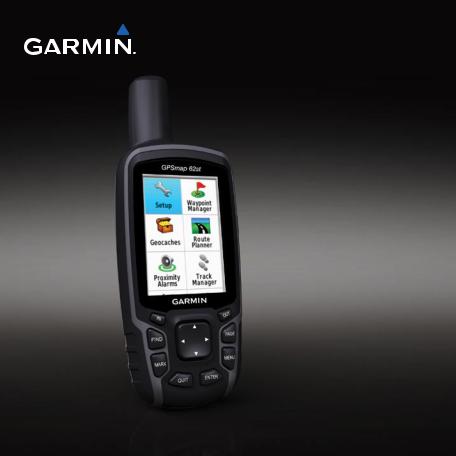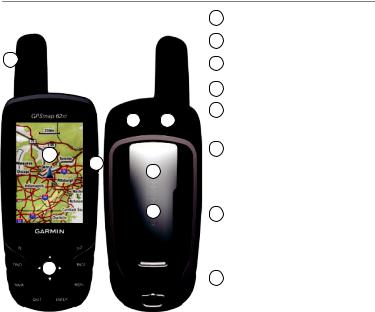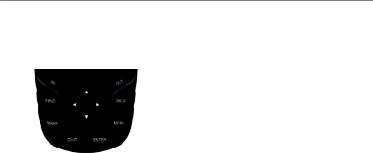Garmin GPSMAP 62s User Manual

GPSMAP® 62 series
owner’s manual
For use with the GPSMAP 62, 62s and, 62st
© 2010 Garmin Ltd. or its subsidiaries |
|
|
Garmin International, Inc. |
Garmin (Europe) Ltd. |
Garmin Corporation |
1200 East 151st Street, |
Liberty House, |
No. 68, Jangshu 2nd Road, |
Olathe, Kansas 66062, |
Hounsdown Business Park, |
Sijhih, Taipei County, |
USA |
Southampton, Hampshire, SO40 9LR UK |
Taiwan |
Tel. (913) 397.8200 or |
Tel. +44 (0) 870.8501241 (outside the UK) |
Tel. 886/2.2642.9199 |
(800) 800.1020 |
0808 2380000 (within the UK) |
Fax 886/2.2642.9099 |
Fax (913) 397.8282 |
Fax +44 (0) 870.8501251 |
|
All rights reserved. Except as expressly provided herein, no part of this manual may be reproduced, copied, transmitted, disseminated, downloaded or stored in any storage medium, for any purpose
without the express prior written consent of Garmin. Garmin hereby grants permission to download a single copy of this manual onto a hard drive or other electronic storage medium to be viewed and to print one copy of this manual or of any revision hereto, provided that such electronic or printed copy of this manual must contain the complete text of this copyright notice and provided further that any unauthorized commercial distribution of this manual or any revision hereto is strictly prohibited.
Information in this document is subject to change without notice. Garmin reserves the right to change or improve its products and to make changes in the content without obligation to notify any person or organization of such changes or improvements. Visit the Garmin Web site (www.garmin.com) for current updates and supplemental information concerning the use and operation of this and other Garmin products.
Garmin®, BlueChart®, g2 Vision®, City Navigator®, and GPSMAP® are trademarks of Garmin Ltd. or its subsidiaries, registered in the USA and other countries. HomePort™, BaseCamp™, ANT™, and ANT+™ are trademarks of Garmin Ltd. or its subsidiaries. These trademarks may not be used without the express permission of Garmin.
Windows® is a registered trademark of Microsoft Corporation in the United States and/or other countries. Mac® is a registered trademarks of Apple Computer, Inc. microSD™ is a trademark of SanDisk or its subsidiaries. Other trademarks and trade names are those of their respective owners.
Table of Contents
Getting Started.................... |
1 |
Manual Conventions.................. |
1 |
Device Overview........................ |
2 |
Battery Information..................... |
2 |
Installing the Batteries................ |
3 |
Turning the Device On or Off..... |
3 |
Acquiring Satellite Signals.......... |
3 |
Buttons....................................... |
4 |
Navigating with Waypoints |
|
and Routes........................... |
5 |
Waypoints.................................. |
5 |
Routes........................................ |
6 |
Additional Maps.......................... |
8 |
Tracks................................... |
9 |
About Tracks.............................. |
9 |
Navigating a Saved Track........ |
10 |
Using the Main Pages........ |
11 |
Customizing the Data Fields..... |
11 |
Restoring Default Page |
|
Settings................................... |
11 |
Map........................................... |
11 |
Compass.................................. |
13 |
Using the Compass.................. |
14 |
Using Sight ‘N Go..................... |
14 |
Elevation Plot........................... |
15 |
Opening the Main Menu........... |
16 |
Trip Computer.......................... |
17 |
Main Menu Features and |
|
Settings.............................. |
18 |
Geocaches............................... |
18 |
Share Wirelessly...................... |
18 |
Proximity Alarms...................... |
19 |
Profile Change......................... |
19 |
Area Calculation....................... |
19 |
Satellite.................................... |
20 |
Additional Main Menu Tools..... |
20 |
Customizing Your |
|
Device................................. |
22 |
Customizing Data Fields.......... |
22 |
Data Field Options................... |
22 |
System Settings....................... |
26 |
Display Settings....................... |
27 |
Setting Up Tones...................... |
27 |
Marine Settings........................ |
27 |
Setting up Marine Alarms......... |
28 |
Resetting Data......................... |
29 |
Changing the Page |
|
Sequence.............................. |
29 |
Customizing the Unit |
|
Settings.................................. |
30 |
Time Settings........................... |
30 |
Position Format Settings.......... |
30 |
Altimeter Settings..................... |
31 |
Geocache Settings................... |
32 |
Routing Settings....................... |
32 |
Fitness...................................... |
33 |
Profiles..................................... |
33 |
Appendix............................ |
34 |
Viewing Important Device |
|
Information............................. |
34 |
Contacting Garmin Product |
|
Support.................................. |
34 |
Using the Backlight.................. |
35 |
Specifications........................... |
35 |
Maximizing Battery Life............ |
36 |
About the Batteries................... |
37 |
Buying Optional Accessories.... |
38 |
Using Optional Fitness |
|
Accessories........................... |
38 |
Data Management.................... |
39 |
Attaching the Wrist Strap......... |
42 |
Attaching the Carabiner Clip.... |
43 |
Caring for the Device............... |
43 |
Troubleshooting....................... |
44 |
Index................................... |
46 |
Registering Your Device........... |
34 |
Updating the Software.............. |
34 |

Getting Started
‹ warning
See the Important Safety and Product Information guide in the product box for product warnings and other important information
When using your device the first time, you should complete the following tasks to set up the device and get to know the basic features.
1.Install the batteries (page 3).
2.Turn on the device (page 3).
3.Acquire satellites (page 3).
4.Mark a waypoint (page 5).
5.Navigate a route (page 7).
6.Record a track (page 9).
7.Calibrate the compass (page 13).
Getting Started
Manual Conventions
When you are instructed to press something, use the buttons on the unit. Use the Rocker to select something in a list, and then press ENTER (page 4).
The small arrows (>) used in the text indicate that you should select a series of items in order, for example, “Select
Delete > Yes.”
GPSMAP 62 Series Owner’s Manual |
|

Getting Started
Device Overview
1
5 6
2
4 7
8
3
1Internal antenna
2Display
3Buttons (page 4)
4
5mini-USB port (under weather cap)
6MCX connector for GPS antenna (under weather cap). Available only on the GPSMAP 62s and the GPSMAP 62st.
7microSD™ card slot (under batteries). Available only on the GPSMAP 62s and the GPSMAP 62st.
8Battery compartment
Battery Information
The device operates on two AA batteries. Use alkaline, NiMH, or lithium batteries. Use precharged
GPSMAP 62 Series Owner’s Manual

NiMH or lithium batteries for best results (page 37).
Installing the Batteries
1.Remove the battery cover by turning the D-ring 1/4 turn counterclockwise and pulling up.
2.Insert the batteries, observing polarity.
3.Replace the battery cover.
For best results, after you install new batteries, update the battery type in the system settings (page 37).
Getting Started
Turning the Device On or Off
Press and hold  .
.
Setting Your Language
1.Turn on the unit.
2.Use the Rocker to select a language.
Acquiring Satellite Signals
It may take 30 to 60 seconds to acquire signals.
1.Go outdoors to an open area.
2.If necessary, turn on the device.
3.Wait while the device searches for satellites.
Aquestion mark flashes while the device determines your location.
4.Quickly press  to open the backlight status page.
to open the backlight status page.
The GPS bars indicate satellite
GPSMAP 62 Series Owner’s Manual |
|

Getting Started
strength. When the bars are green, the device has acquired satellite signals.
Buttons
FIND |
Press FIND to open the |
|
search menu. |
|
|
MARK |
Press MARK to save |
|
your current location as a |
|
waypoint. |
QUIT |
Press QUIT to cancel |
|
or return to the previous |
|
menu or page. |
ENTER |
Press ENTER to select |
|
options and acknowledge |
|
messages. |
|
|
MENU |
Press MENU to open |
|
the options menu for the |
|
page that is currently |
|
open. |
|
Press MENU twice to |
|
open the main menu |
|
(from any page). |
PAGE |
Press PAGE to scroll |
|
through the main pages |
|
(page 11). |
|
|
Rocker |
Press up, down, right, |
|
and left to select menu |
|
options and to move the |
|
map cursor. |
IN |
Press IN to zoom in on |
|
the map. |
|
|
OUT |
Press OUT to zoom out |
|
on the map. |
|
|
|
GPSMAP 62 Series Owner’s Manual |

Navigating with Waypoints and Routes
Waypoints
Waypoints are locations you record and store in the device.
Creating Waypoints
1.From any page, press MARK.
2.Select Done.
Navigating to a Waypoint Using the Search Menu
You can use the search menu to quickly find waypoints, tracks, routes, and coordinates that you have saved.
1.From any page, press FIND.
2.Select Waypoints.
3.Select a waypoint.
4.Select Go.
Navigating with Waypoints and Routes
Editing a Waypoint
Before you can edit a waypoint, you must create a waypoint.
1.From the main menu, select
Waypoint Manager.
2.Select a waypoint.
3.Select an attribute (such as the name or location).
4.Enter the new information.
5.Select Done.
Deleting a Waypoint
1.From the main menu, select
Waypoint Manager.
2.Select a waypoint.
3.Press Menu.
4.Select Delete.
GPSMAP 62 Series Owner’s Manual |
|

Navigating with Waypoints and Routes
Routes
A route is a sequence of waypoints that leads you to your final destination.
Your device can store up to 50 routes with up to 250 points each.
Creating a Route
1.From the main menu, select Route Planner > Create Route > Select First Point.
2.Select a category.
3.Select the first point in the route.
4.Select Use.
5.Select Select Next Point.
6.Repeat steps 2–5 until the route is complete.
A route must contain at least two points.
7.Press quit to save the route.
Editing the Name of a Route
1.From the main menu, select Route Planner.
2.Select a route.
3.Select Change Name.
4.Enter the new name.
5.Select Done.
Editing a Route
1.From the main menu, select Route Planner.
2.Select a route.
3.Select Edit Route.
4.Select a point.
5.Select an option:
•Review—shows the point on the map.
•Move Down (or Up)—changes the order of the point on the route.
GPSMAP 62 Series Owner’s Manual

•Insert—adds an additional point on the route.
The additional point is inserted before the point you are editing.
•Remove—removes the point from the route.
Viewing a Route on the Map
1.From the main menu, select Route Planner.
2.Select a route.
3.Select View Map.
Deleting a Route
1.From the main menu, select Route Planner.
2.Select a route.
3.Select Delete Route.
Navigating a Route
1.Press FIND.
2.Select Routes.
Navigating with Waypoints and Routes
3.Select a route.
4.Select Go.
Viewing the Active Route
1.From the main menu, select Active Route.
2.Select a point in the route to view additional details.
Stopping Navigation of a Route
1.From any page, press FIND.
2.Select Stop Navigation.
Navigating a Reverse Route
1.From the main menu, select Route Planner.
2.Select a route.
3.Select Reverse Route.
4.Select the route again.
5.Select View Map > Go.
GPSMAP 62 Series Owner’s Manual |
|

Navigating with Waypoints and Routes |
|
|
Additional Maps |
6. |
Enter the house number. |
To purchase preloaded detailed map |
7. |
Enter the street. |
data cards, go to http://buy.garmin.com |
8. |
Select Go. |
or contact your Garmin dealer. |
|
|
Finding an Address with City Navigator®
You can use optional City Navigator maps to search for addresses, cities, and other locations. The detailed maps contain millions of points of interest, such as restaurants, hotels, and auto services.
1.Press FIND.
2.Select Addresses.
3.Enter the country.
4.Enter the city or postal code.
NOTE: Not all map data provides postal code searching.
5.Select the city.
|
GPSMAP 62 Series Owner’s Manual |

Tracks
About Tracks
Your Garmin device records a track log while you are moving. You can save these tracks and navigate to them later.
You can view archived or loaded tracks by selecting Track Manager from the main menu.
Managing Track Log Recording
1.From the main menu, select Setup
> Tracks > Track Log.
2.Select Record, Do Not Show or Record, Show On Map.
If you select Record, Show On Map, a line on the map indicates your track.
3.Select Record Method.
Tracks
4.Select an option:
•Distance—records tracks at a specified distance.
•Time–records tracks at a specified time.
•Auto—records tracks at a variable rate to create an optimum representation of your tracks.
5.Select Recording Interval.
6.Select an option to record tracks more or less often.
NOTE: Using the Most Often interval provides the most track detail and fills up the device memory quicker.
GPSMAP 62 Series Owner’s Manual |
|

Tracks
Viewing the Current Track
The track being recorded is called the current track.
1.From the main menu, select Track Manager > Current Track.
2.Select an option:
•View Map—shows the current track on the map.
•Elevation Plot—shows the elevation plot (page 15) for the current track.
Saving the Current Track
1.From the main menu, select Track Manager > Current Track.
2.Select what you want to save:
•Save Track—saves the entire active track.
•Save Portion—allows you to select a portion of the current track to save.
Clearing the Current Track
From the main menu, select Setup
> Reset > Clear Current Track >
Yes.
Deleting a Track
1.From the main menu, select Track Manager.
2.Select a track.
3.Select Delete > Yes.
Navigating a Saved Track
You must record and save a track before you can navigate using it.
1.Press FIND.
2.Select Tracks.
3.Select a saved track.
4.Select Go.
10 |
GPSMAP 62 Series Owner’s Manual |

Using the Main Pages
The information needed to operate this device is found on the following pages: map, compass, main menu, and trip computer.
Customizing the Data Fields
You can customize the data fields that appear on the main pages. For data field descriptions, see page 22.
1.From a main page, press meNu.
2.Select Change Data Fields.
3.Select a data field.
4.Follow the on-screen instructions.
Restoring Default Page
Settings
1.From a main page, press meNu.
2.Select Restore Defaults.
3.Press enter.
Using the Main Pages
Map
The  position icon represents your location on the map. As you travel, the position icon moves and leaves a track log (trail). Waypoint names and symbols also appear on the map.
position icon represents your location on the map. As you travel, the position icon moves and leaves a track log (trail). Waypoint names and symbols also appear on the map.
Changing the Map Orientation
1.From the map, press MENU.
2.Select Setup Map > Orientation.
3.Select an orientation:
•Select North Up to show north at the top of the page.
•Select Track Up to show your current direction of travel at the top of the page.
•Select Automotive Mode to show a perspective view.
GPSMAP 62 Series Owner’s Manual |
|

Using the Main Pages
Measuring Distance
You can move the cursor around the map to measure distance from the current location.
1.From the map, press MENU.
2.Select Measure Distance.
The device automatically begins measuring from your current location.
3.Move the cursor to a point you want to measure to.
The distance appears at the bottom of the page.
4.Press quit to stop measuring.
Map Setup Options
From the map, press menu, and select Setup Map.
•Map Orientation—allows you to select how the map is displayed (page 11).
•Guidance Text—allows you to select when to show guidance text on the map.
•Advanced Map Setup
◦Auto Zoom—automatically selects the appropriate zoom level for optimal use on your map. When Off is selected, you must zoom in or out manually.
◦Zoom Levels—map items draw or appear at or below the selected zoom level.
◦Text Size—allows you to select the text size for map items.
◦Detail—allows you to select the amount of map data displayed on the device.
note: Higher detail settings may cause the map to redraw slowly.
•Shaded Relief—shows detail relief on the map (if available) or turns off shading.
12 |
GPSMAP 62 Series Owner’s Manual |

•Map Information—allows you to enable or disable the maps currently loaded on the device. To purchase additional maps, see page 38.
Compass
When navigating to a destination, the bearing pointer points to your destination, regardless of the direction you are moving. When the bearing pointer points toward the top of the electronic compass, you are traveling directly toward your destination. If
it points any other direction, turn toward that direction until the arrow is pointing toward the top of the compass.
Using the Main Pages
Calibrating the Compass
notice
Calibrate the electronic compass outdoors. Do not stand near objects that influence magnetic fields, such as cars, buildings, or overhead power lines.
note: The three-axis compass is available only with the GPSMAP 62s and GPSMAP 62st.
You should calibrate the compass after moving long distances, experiencing temperature changes, or changing the batteries.
1.From the compass, press MENU.
2.Select Calibrate Compass > Start.
3.Follow the on-screen instructions.
GPSMAP 62 Series Owner’s Manual |
|
